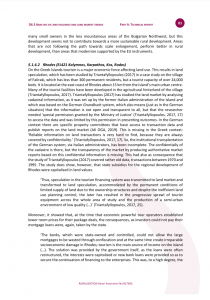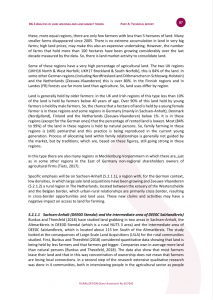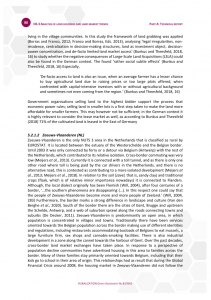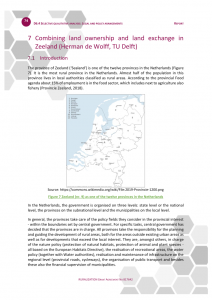
Access to land: resources database

D6.3 Quantitative analysis of land holdings abd land market trends – CAP grants and Polish rural regions
Section title:5.2.5.1 CAP grants and Polish rural regions
Highlights:
In the Polish context the CAP contributions are higher than rent, which means that private owners rarely lease-out their land. However, which does takes place, according to surveys, are informal leases between neighbours, the CAP is not received by the actual farmer, but by the formal one.
D6.3 Quantitative analysis of land holdings abd land market trends – Ownership of shareholder outside the region in the East of Germany
Section title: 5.2.2.1 Ownership of shareholder outside the region in the East of Germany
Highlights:
The regulations in Germany do not restrict the transfer of shares of a farmland-owning company. Transactions of family farms, owned by natural persons, are observed and restricted by the Land parcel transaction law (‘Grundstücksverkehrsgesetz’), these transactions are not. So, in a comparative way, the current legal structure support shareholders transactions (no control) compared to family farm transactions (control). Many owners are from outside the region and the connection between farmers and local politicians are broken.
D6.3 Quantitative analysis of land holdings abd land market trends – Remote regions in Poland
Section title: 5.1.2.1 Remote regions in Poland (PL219 Nowotarski; PL523 Nyski; PL618 Swiecki; PL637 Chojnicki; PL811 Bialski; PL821 Krosnienski)
Highlights:
The context lof land markets in Polish remote rural regions difers considerably. The physical condition as a mountain area, seems more important than the remoteness in the development towards farmland abandonment. Based on this it may be expected that infrastructure investments to counter remoteness, or the creation of jobs outside the agricultural sector will not stop farmland abandonment.
D6.3 Quantitative analysis of land holdings abd land market trends – Rhodes
Section title: 5.1.4.2 Rhodes (EL421 Kalymnos, Karpathos, Kos, Rodos)
Highlights:
On the Greek Islands tourism is a major economic force affecting land use. This results in land speculation: subsidies for the regional development of Rhodes were capitalised in land values. Moreover, at the time that economic powerful tour operators established lower room prices for their package deals, the consequences, as investors could not pay their mortgage loans were, again, taken by the state.So, the state funded the land speculation in two instalments, first by its economic development policies and, second, by its bale out policies after it has shown that expectations based on which high land prices were paid were too high.
D6.3 Quantitative analysis of land holdings abd land market trends – Sachsen-Anhalt
Section title: 5.2.1.1 Sachsen-Anhalt (DEE0D Stendal; and the intermediate area of DEE0C Salzlandkreis)
Highlights:
Large-Scale Land Acquisitions (LSLA) have impact on rural communities. Government organisations selling land to the highest bidder support the process that economic power rules; selling land in smaller lots is a first step taken to make the land more affordable for smaller farmers.
D6.3 Quantitative analysis of land holdings abd land market trends – Sami
Section title: 5.1.1.2 Sami
Highlights:
The Northern regions in Sweden and Finland, just as the adjacent areas in Norway and Russia, are the home of Sami who practice a traditional form of reindeer husbandry. Land is a scare resource in the least dense-populated region of the EU (1.8 inhabitants per km2), but also the issue of access to land for new generations is of importance. Political decision making is central here. Traditional agents promoting other interests had much better access to policy making than the Sami communities and step-by-step actions are taken to change this. However, this is a slow process.
D6.3 Quantitative analysis of land holdings abd land market trends – Scotland: Large landowners, small tenants
Section title: 5.1.1.1 Scotland: Large landowners, small tenants
Highlights:
Scotland can be seen as an archetype of traditional land relationships with a few large landowners and many small tenants. Deevelopments and discussions are analysed.

D6.3 Quantitative analysis of land holdings abd land market trends – Teleorman in its Romanian context
Section title: 5.1.3.1 Teleorman in its Romanian context
Highlights:
In Romania a dual land market of many small holders and a few large landholders is a general issue. Th concept of land grabbing is used to analyse developments. The Teleorman case study shows how this works in a local context of ‘special relationships’ between politicons and entrepreneurs and a diversity of ethnic (Including Roma) and cultural groups.
D6.3 Quantitative analysis of land holdings abd land market trends – Zeeuws-Vlaanderen
Section title: 5.2.1.2 Zeeuws-Vlaanderen (NL)
Highlights:
Cross-border relationships between rural Zeeuws-Vlaanderen en urban areas in Belgean result in issues on access to land. Ramers consider this a large threat. Local authorities seek releationships with counterparts accross the border.
D6.4 Selective qualitative analysis incl 8 legal and policy arrangements – 2 Developments on new Agricultural Structure Acts and the case of Thuringia in Germany
Section title: 2 Developments on new Agricultural Structure Acts and the case of Thuringia in Germany (Kati Volgmann, ILS)
Highlights:
The study demonstrates the potential and limitation of regional policy interventions, regarding the fair distribution of agricultural land / The study shows the diversity and specific legal conditions of land markets, even within member states of the EU
D6.4 Selective qualitative analysis incl 8 legal and policy arrangements – Access to farmland in Poland
Section title: D6.4 Selective qualitative analysis incl 8 legal and policy arrangements
Highlights:
There is a general agreement, both across various perspectives that can be found in secondary sources as well as among the persons interviewed for the purpose of this case study, that current regulations of access to farmland in Poland have been successful in limiting the problem of land grabbing and speculation – and thus the increase of prices of farmland associated with these problems. The logic of state interventionism, the underlying assumptions of the regulations and their general structure is generally not contested. However, there are various lines of criticism referring to some aspects of the regulations. In order to illustrate them, in the report we summarize the perspectives of the interviewees participating in this case study.
D6.4 Selective qualitative analysis incl 8 legal and policy arrangements – Analysis of the structures’ policy (SDREA and CDOA), Case studies: Nord and Côte d’Or
Section title: Analysis of the structures’ policy (SDREA and CDOA), Case studies: Nord and Côte d’Or

D6.4 Selective qualitative analysis incl 8 legal and policy arrangements – Combining land ownership and land exchange in Zeeland
Section title: Combining land ownership and land exchange in Zeeland
Subsection: 7
Highlights:
The province of Zeeland (The Netherlands) combines a land bank and voluntary exchanges between landowners to contribute to its environment and planning vision. By combining the land bank with voluntary exchanges between parties, the yardstick of the provincial land policy reaches further than its land portfolio alone. To enable to do so, the province has appointed regional land exchange contact persons that are outside the bureaucracy to ascertain that local knowledge of land policy opportunities are fed into the exchanges. Currently, the policies are mostly related towards improvement of the farm structure, biodiversity areas, recreational areas and infrastructure. Land policy is a tool to implement the vision and facilitating new entrants to farming makes no part of the vision amended in 2016. Currently the draft vision is developing in promoting new chances for young people in the province and achieving a sustainable agriculture. After the vision is adapted, a novel land policy will follow, which will change its direction towards new aims of the vision; which potentially will provide a larger chance for providing access to land for new generations. Currently a new vision is in preparation, which vision will be followed by a new land policy report, which serves as tool to implement the vision. In this vision sustainable agriculture and the attractiveness of the province for young people and families are on the agenda, which may result in that the current instrumental set-up of a land bank, plus voluntary exchanges, including a reticulist role of bringing landowners and new entrants together, may be used for these aims as well.
D6.4 Selective qualitative analysis incl 8 legal and policy arrangements – Privatization of farmland in Hungary
Section title: Privatization of farmland in Hungary

D6.4 Selective qualitative analysis incl 8 legal and policy arrangements – Territorial food plans in France: Do they facilitate access to land for new generations?
Section title: Territorial food plans in France: Do they facilitate access to land for new generations?






